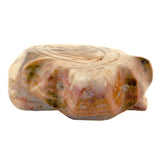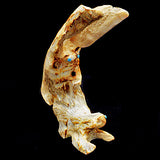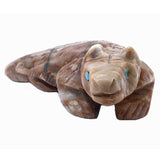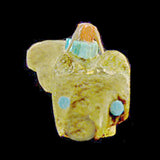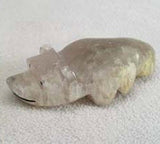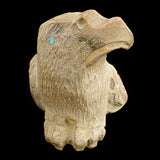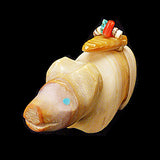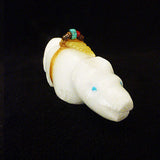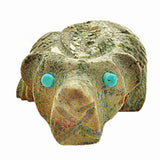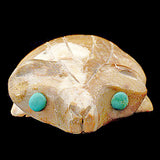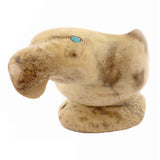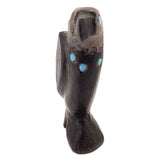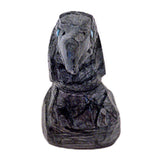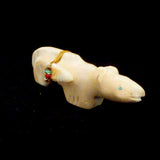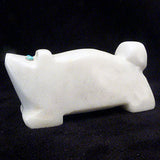Six Directional Zuni Fetish Animals
We have created this page so you can see the six animals the Zuni venerate. Zuni society recognizes six cardinal directions - that means the North, South, East and West as well as the Zenith: aka: the Sky and the lower region - called the Nadir. Each direction is represented by one of the six directional animals. The six animals the Zuni honor are: the Bear, the Eagle, the Mountain Lion, the Wolf, the Badger and the Mole. Each animal is given a particular color designation and the animal is the guardian of its region and the master of the medicine powers for that particular region. The six animals possess different powers and in traditional Zuni culture, the animal called upon depended on the power needed. We list the the Six Directional animals below and give a brief description. On this page, you will find the Six Directional animals as well as Six-Directional Sets and Six-Directional Figures in order of price. By starting out with the six traditional animals - you can learn about the Zuni fetish. Then you can branch off into collecting the animals that speak to you.
The Bear: For the Zuni, the bear is an animal endowed with curative powers, strength, adaptability and courage, and in both the spiritual and physical realm, is a close human associate. Many sources cite that Zuni hunters familiar with the bear's anatomy are struck by its physical similarity to that of humans. Elder brother of the badger, the bear assumes the western direction in a protective directional set, and, associated with blue, is often but not exclusively carved in turquoise or lapis. White bears are regarded as particularly potent healers. The bear's association with healing may stem from its ability to hibernate in adaptation to seasonal change in food supply.
The Eagle: As mighty denizen of the skies, the eagle naturally assumes the direction of above in the six directional arrangement. The raptor's power, strength, and dynamic grace earn it high regard in Zuni culture, and the eagle is at once teacher, creator, loyal intuitive, and because of its ability to freely survey the land below from skies high above, is intermediary between humans and the great divine. Its celestial affiliation is often expressed in carvings that use white, iridescent, or multicolored stones.
Mountain Lion: The reclusiveness and stealth of this large cat establish it in Zuni mythos as a totem of independence, agility, strength, and choose-to-follow-me-or not leadership. As guardian of the northern direction, the mountain lion offers protection from northerly threats such as winter. This lithe predator is often carved in yellow or golden stones such as dolomite or calcite, and in keeping with the style of the earliest, more primitive mountain lion carvings, Zuni artistic convention is to carve the mountain lion's tail up over its back. The mountain lion enjoys the prestige of being one of the most capable of predators and therefore conveys to man a spirit to refine goals, persevere, and achieve.
Wolf: The wolf is a member of the healing directional set, regarded by the Zuni as younger brother of the bobcat and guardian of the east. As a social predator living and hunting within the family group of the pack, the wolf naturally represents loyalty to family and tribe, and is viewed as both teacher and pathfinder. The wolf's wide territory and ability to communicate over long distances make it a particularly apt emblem for life's never ending journey. The wolf's commensal relationship with humans as well as its direct ancestry to the modern day dog establish it positively in Zuni culture as man's steadfast ally, and in some cases, his watchdog. Most often associated with the color white, the wolf is frequently carved in white marble, alabaster or selenite, and carvers often portray it in a stalking pose, with alert small triangular ears, and in contrast to the coyote, with a tail that hangs.
Badger: The badger, that tenacious and stout omnivore, represents the southern direction in the directional set, and associated with red, is often carved in pipestone, dolomite, or onyx. The Zuni believe because it possesses knowledge of roots and medicinal plants and herbs, the badger is knowledgeable in curing illness and injury. Badgers are attributed with passion, control, persistence as well as earthiness, and are associated with the sun. The Badger Clan, one of Zuni's major clans, is entrusted at the winter solstice to encourage the sun to return from its southern sojourn. Carvers would seem to relish depicting the badger's telltale stripe, often carving from a carefully chosen piece of rock that has a vein perfectly placed to represent the stripe.
Mole: Another subterranean dweller is the mole, unassuming protector of crops and guardian of the underworld. Not surprisingly, the mole is associated with the position below in the directional set and the color black, so is often carved in jet or black marble. Moles are beneficial and serve to remind us of life's subtle changes and incremental progression. The Zuni further believe moles to be intermediaries between humans and the powers of the netherworld. Moles are truly blind, but carvers frequently choose to give them eyes.






